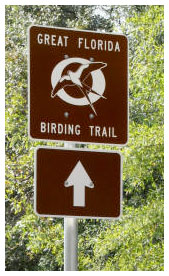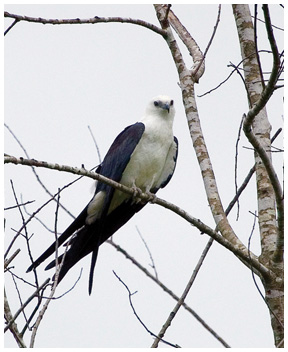
Florida’s birding trail symbol is often spotted gliding around Walton County
The swallow-tailed kite is a snack-food junkie if ever there was one. It spends most of the day aloft, eating on the run – catching bugs and eating them in one swoop, then circling and diving to devour another.
Elanoides forficatus is also an energy miser. The kite uses thermal uplifts and winds to spend the day gliding, merely flipping one side of its forked tail to change direction. From its nest in the top of tall pines and cypress trees, it spies arboreal vertebrates – reptiles, amphibians and sometimes a fledgling from another nest – and can seize that prey mid-flight.

The black-and-white beauty’s picture is everywhere. The Florida Fish and Wildlife Conservation Commission (FWC) features the kite, a white-tailed deer and spotted seatrout on its logo. Motorists probably have noticed an image of the kite on signs throughout the state designating the 489 Great Florida Birding Trail sites.
Swallow-tailed kites made a good symbol for Florida’s birding trail for many reasons. “Florida has more swallow-tailed kites than the rest of the nation combined,” said Mark Kiser, a biological scientist with the FWC’s Office of Recreation Services, Wildlife Viewing Section. “It is easily identifiable by color and shape. Its underside is snow white with long, narrow wings edged in black feathers. Its opposite colors are clearly defined. In addition, not many birds share its unique silhouette – a deeply forked, black tail.”
Although beautiful and graceful, the kite represents a species that can use people’s help. One reason is its own housing crisis due to habitat loss from drained wetlands.
The Australian pine, an invasive species, also changed the kite’s habitat, replacing the bird’s preferred cypresses and native pines. Think of the three little pigs, one of whom built a straw house. The big, bad wolf blew it down. The Australian pine does not make a good house either. According to Audubon of Florida, the nonnative tree, although offering good height, “often fails to support nests.” Big, bad winds frequently topple Australian pines because of their shallow roots.
Many agencies recognize that wetland preservation and restoration, as well as eradication of the Australian pine, are solutions to the kites’ housing crisis during nesting season.
Swallow-tailed kites form loose colonies when they nest. Dr. Kenneth D. Meyer received a grant from the FWC to study the kite’s roosting needs. In his 1989 report, Meyer noted that the kite formed groups of 10 to 40 birds when nesting.
After nesting is completed, the kites migrate southward and form large communal roosts, often clustered in isolated South Florida sites.
“Some of these communal roosts, particularly in Everglades National Park, were active until late August or early September,” Meyer wrote.

By September, swallow-tailed kites lift off and head for Brazil, hopping across the Caribbean islands to the Yucatan Peninsula to reach the Central America flyway.
Come spring, they return to North America. The swallow-tailed kite used to have a larger distribution (up to 21 states), Kiser said, but now its U.S. breeding range is confined to Florida and pockets of suitable habitat from Texas to South Carolina.
“Interestingly, you rarely see them perched during the day,” Kiser said. “They’re nearly always flying. They circle overhead like any bird of prey. And I’ve seen them make an inverted, backward dive to catch an insect.”
Nature writer and activist Susan Cerulean, in “Tracking Desire: A Journey After Swallow-tailed Kites” (University of Georgia Press), roamed the kite’s fragmented habitat to learn about this captivating bird and the threats it faces.
“My journeys after kites have led me to understand that the power of our longings is placing the integrity of life on our tender emerald planet … at risk. What are the fractured places in our hearts and minds and spirits that have allowed us to stand by and watch, and even to participate in, the destruction of so much of life?”
The swallow-tailed kite is declining, Kiser said. “That is another reason people cherish it so much.”
Swallow-tailed kite traits
Its cry is faint but shrill. Some say it sounds like ee-ee-ee or peet-peet-peet.
Length, 24 inches; wingspan, 4 feet.
A kite may bring an entire wasp nest to its own nest. Kite chicks feed on the wasp larvae.
Kite feet are small and weak, compared with those of other raptors.
All it takes to open up the fascinating world of birding and wildlife is a bird book or pamphlet, a pair of binoculars and maybe a camera.
Information provided by Florida Fish and Wildlife Conservation Commission

kelly
August 3, 2009Powerful statement,
” What are the fractured places in our hearts and minds and spirits that have allowed us to stand by and watch, and even to participate in, the destruction of so much of life?”
Darisse
July 13, 2011I have seen some raptors not sure if they are black though I think that they are brown and white would like to know more about htem if you have any info or know where I can find some.
Darisse
July 13, 2011I live in Florida and have not seen them here before.
Walton Outdoors
July 13, 2011Swallow-tailed kites are typically only in Northwest Florida during the springtime.